“A Mongolian neo-Nazi group has rebranded itself as an environmentalist organization fighting pollution by foreign-owned mines, seeking legitimacy as it sends Swastika-wearing members to check mining permits. Tsagaan Khass, or White Swastika, has only 100-plus members but it is one of several groups with names like Dayar Mongol (Whole Mongolia), Gal Undesten (Fire Nation) and Khukh Mongol (Blue Mongolia), expanding a wave of resource nationalism as foreign firms seek to exploit the mineral wealth of the vast country, landlocked between Russia and China.
From an office behind a lingerie store in the Mongolian capital, the shaven-headed, jackbooted Tsagaan Khass storm-troopers launch bizarre raids on mining projects, demanding paperwork or soil samples to be studied for contaminants. “Before we used to work in a harsh way, like breaking down doors, but now we have changed and we use other approaches, like demonstrations,” the group’s leader, Ariunbold Altankhuum, 40, told Reuters, speaking through a translator.
On a patrol to a quarry in grasslands a dusty two-hour ride from the capital, members wore black SS-style Nazi uniforms complete with lightning flashes and replica Iron Crosses. They questioned a mine worker against the sound of machinery grinding stones about paper work, opting to return in a week when the owner had returned. “Today our main goal is to save nature. We are doing things to protect the environment,” Altankhuum said. “The development of mining is growing and has become an issue.”
The group, founded in the 1990s, says it wants to halt pollution in the landlocked former Soviet satellite as foreign companies dig for gold, copper, coal and iron ore using cheap labor from neighboring China and nearby Southeast Asia. But a lot of the pollution is caused by local, illegal miners working individually. “We used to talk about fighting with foreigners, but some time ago we realized that is not efficient, so our purpose changed from fighting foreigners in the streets to fighting the mining companies,” Altankhuum said.
Foreign-invested mining companies contacted by Reuters either were unavailable for comment or did not want to comment. Mongolians fear foreign workers are taking up scarce jobs in an economy where nearly 30 percent of the population lives below the poverty line, according to the Asia Development Bank. “Mining is important because it’s 90 percent of our economy,” said political commentator Dambadarjaa Jargalsaikhan. “But the unequal channeling of this revenue, the inequality in this country, that’s the major issue.”
Not helping the Tsagaan Khass environmental credentials among mainstream observers, apart from the uniforms, is Altankhuum’s reverence for Adolf Hitler. “The reason we chose this way is because what is happening here in Mongolia is like 1939, and Hitler’s movement transformed his country into a powerful country,” he said”. – Carlos Barria via Reuters
From an office behind a lingerie store in the Mongolian capital, the shaven-headed, jackbooted Tsagaan Khass storm-troopers launch bizarre raids on mining projects, demanding paperwork or soil samples to be studied for contaminants. “Before we used to work in a harsh way, like breaking down doors, but now we have changed and we use other approaches, like demonstrations,” the group’s leader, Ariunbold Altankhuum, 40, told Reuters, speaking through a translator.
On a patrol to a quarry in grasslands a dusty two-hour ride from the capital, members wore black SS-style Nazi uniforms complete with lightning flashes and replica Iron Crosses. They questioned a mine worker against the sound of machinery grinding stones about paper work, opting to return in a week when the owner had returned. “Today our main goal is to save nature. We are doing things to protect the environment,” Altankhuum said. “The development of mining is growing and has become an issue.”
The group, founded in the 1990s, says it wants to halt pollution in the landlocked former Soviet satellite as foreign companies dig for gold, copper, coal and iron ore using cheap labor from neighboring China and nearby Southeast Asia. But a lot of the pollution is caused by local, illegal miners working individually. “We used to talk about fighting with foreigners, but some time ago we realized that is not efficient, so our purpose changed from fighting foreigners in the streets to fighting the mining companies,” Altankhuum said.
Foreign-invested mining companies contacted by Reuters either were unavailable for comment or did not want to comment. Mongolians fear foreign workers are taking up scarce jobs in an economy where nearly 30 percent of the population lives below the poverty line, according to the Asia Development Bank. “Mining is important because it’s 90 percent of our economy,” said political commentator Dambadarjaa Jargalsaikhan. “But the unequal channeling of this revenue, the inequality in this country, that’s the major issue.”
Not helping the Tsagaan Khass environmental credentials among mainstream observers, apart from the uniforms, is Altankhuum’s reverence for Adolf Hitler. “The reason we chose this way is because what is happening here in Mongolia is like 1939, and Hitler’s movement transformed his country into a powerful country,” he said”. – Carlos Barria via Reuters
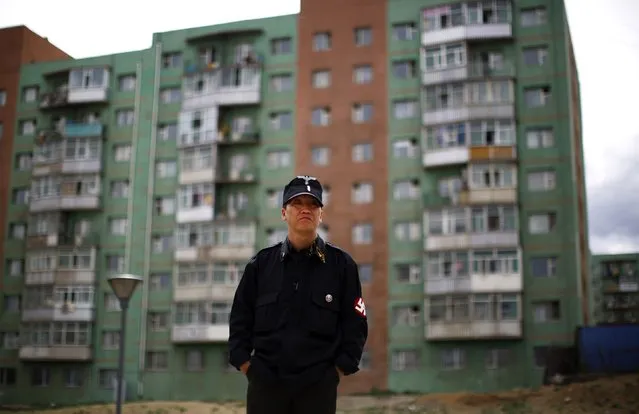
Ariunbold Altankhuum, founder of Mongolian neo-Nazi group Tsagaan Khass, stands next to a statue of Chingunjav, a Mongolian national hero (unseen), in Ulan Bator June 22, 2013. The group has rebranded itself as an environmentalist organisation fighting pollution by foreign-owned mines, seeking legitimacy as it sends Swastika-wearing members to check mining permits. Over the past years, ultra-nationalist groups have expanded in the country and among those garnering attention is Tsagaan Khass, which has recently shifted its focus from activities such as attacks on women it accuses of consorting with foreign men to environmental issues, with the stated goal of protecting Mongolia from foreign mining interests. This ultra-nationalist group was founded in the 1990s and currently has 100-plus members. (Photo by Carlos Barria/Reuters)
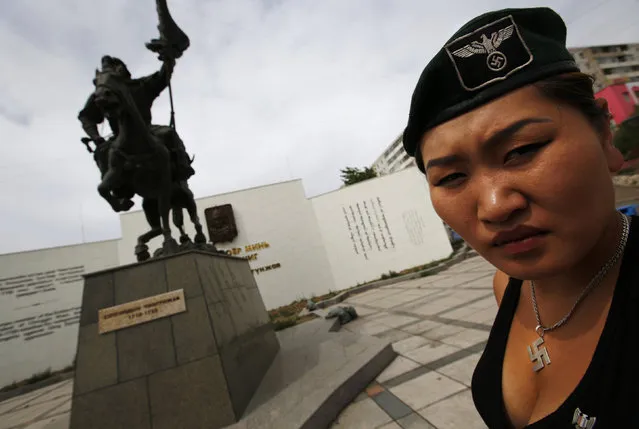
Uranjargal, a leader of the Mongolian neo-Nazi group Tsagaan Khass, stands next to a statue of Chingunjav, a Mongolian national hero, in Ulan Bator June 22, 2013. (Photo by Carlos Barria/Reuters)
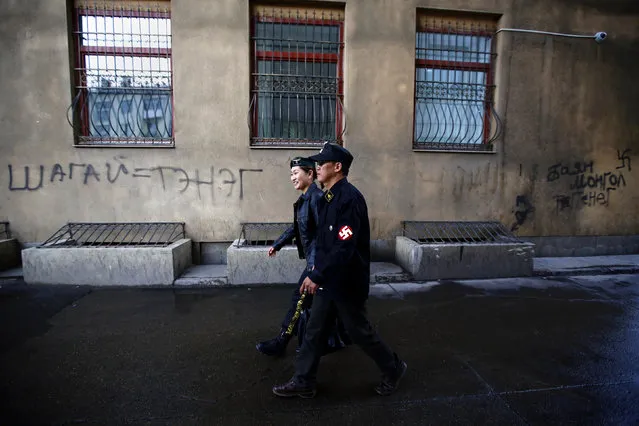
Ariunbold and Uranjargal (L), leaders of the Mongolian neo-Nazi group Tsagaan Khass, leave the group's headquarters in Ulan Bator June 22, 2013. (Photo by Carlos Barria/Reuters)

A swastika is seen on the seat of a car belonging to Ariunbold, leader of the Mongolian neo-Nazi group Tsagaan Khass, as he drives along a busy street in Ulan Bator June 22, 2013. (Photo by Carlos Barria/Reuters)
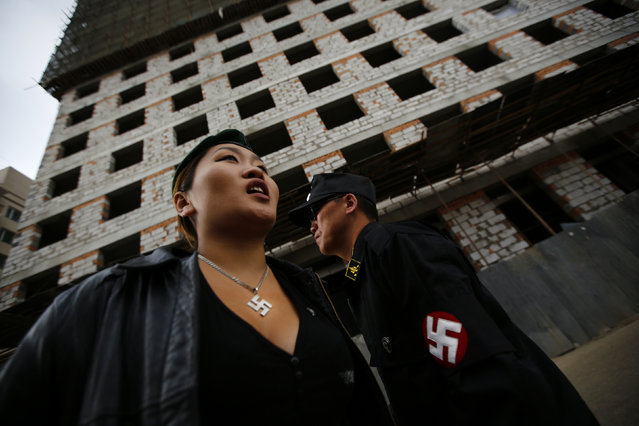
Ariunbold and Uranjargal (L), leaders of the Mongolian neo-Nazi group Tsagaan Khass, stand next to a construction site in Ulan Bator June 22, 2013. (Photo by Carlos Barria/Reuters)
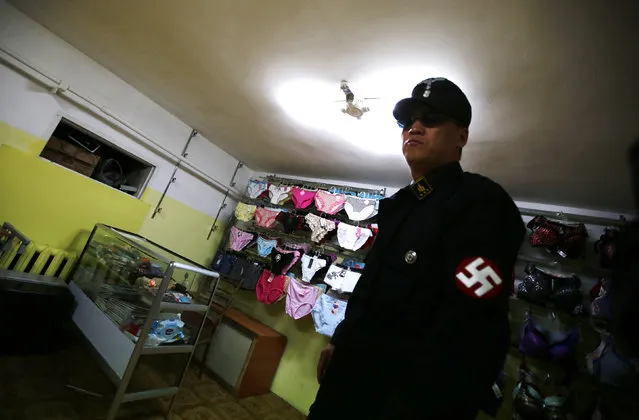
Ariunbold, a leader of the Mongolian neo-Nazi group Tsagaan Khass, walks through a lingerie store as he leaves the group's headquarters in Ulan Bator June 22, 2013. (Photo by Carlos Barria/Reuters)
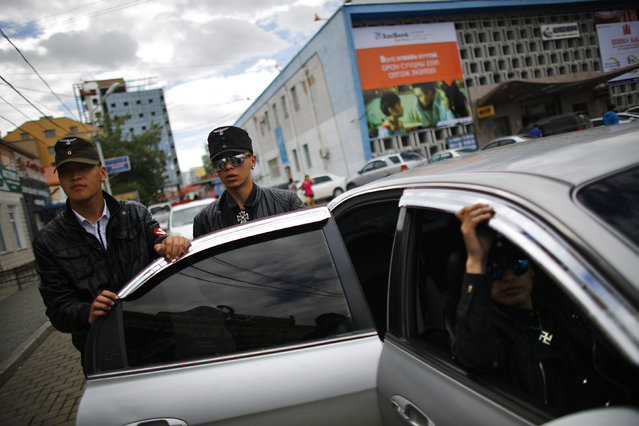
Members of the Mongolian neo-Nazi group Tsagaan Khass leave their headquarters in Ulan Bator June 23, 2013. (Photo by Carlos Barria/Reuters)
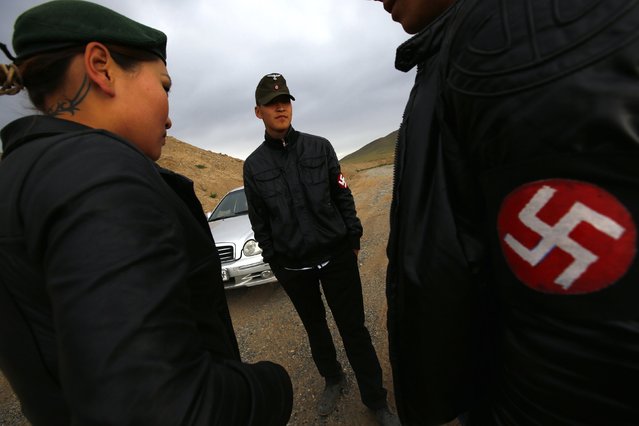
Members of the Mongolian neo-Nazi group Tsagaan Khass stand near a quarry, where they questioned a worker, southwest of Ulan Bator June 23, 2013. (Photo by Carlos Barria/Reuters)
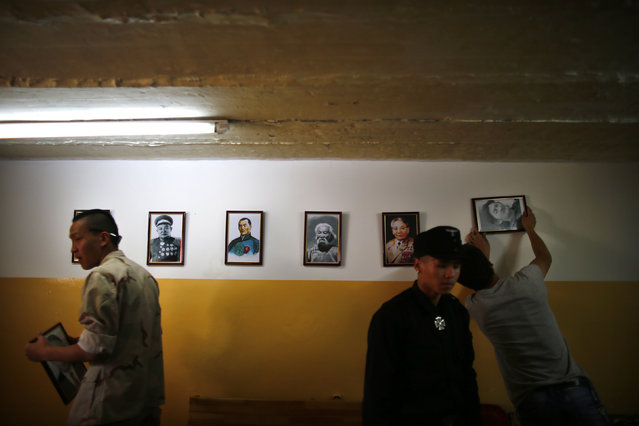
Members of the Mongolian neo-Nazi group Tsagaan Khass hang up portraits of Mongolian heroes at the group's headquarters in Ulan Bator June 24, 2013. (Photo by Carlos Barria/Reuters)

Members of the Mongolian neo-Nazi group Tsagaan Khass walk through a quarry, where they questioned a worker, southwest of Ulan Bator June 23, 2013. (Photo by Carlos Barria/Reuters)
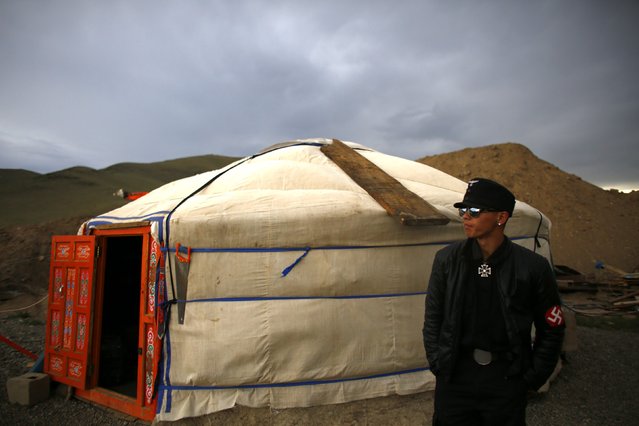
A member of the Mongolian neo-Nazi group Tsagaan Khass stands next to a 'ger', a traditional Mongolian tent, at a quarry, where they questioned a worker, southwest of Ulan Bator June 23, 2013. (Photo by Carlos Barria/Reuters)
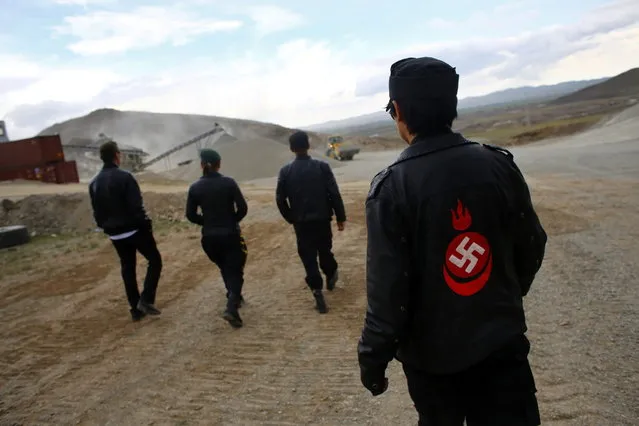
Members of the Mongolian neo-Nazi group Tsagaan Khass walk through a quarry, where they questioned a worker, southwest of Ulan Bator June 23, 2013. (Photo by Carlos Barria/Reuters)
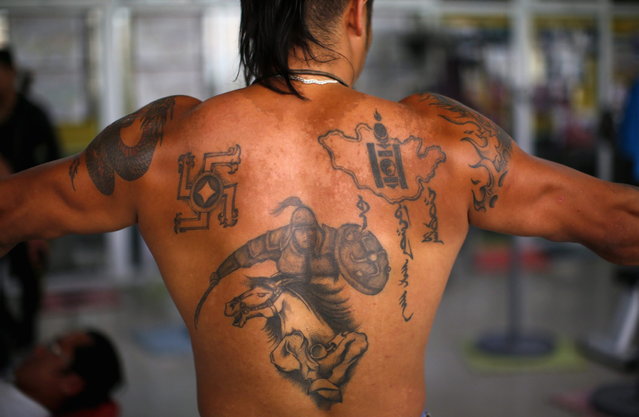
Tattoos are seen on the back of a member of a self-described skinhead group as he trains at a gym in Ulan Bator June 22, 2013. (Photo by Carlos Barria/Reuters)
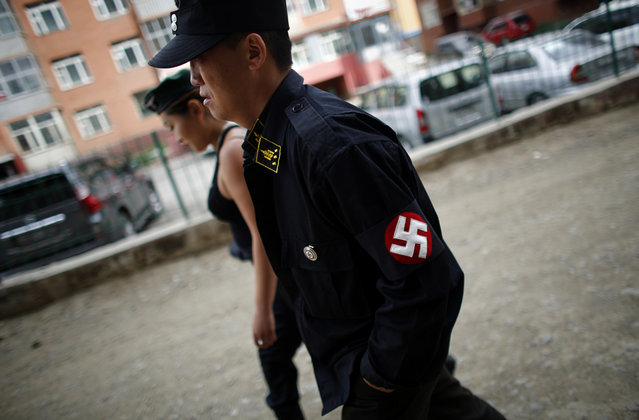
Members of Mongolian neo-Nazi group Tsagaan Khass walk along a street in Ulan Bator, on June 22, 2013. (Photo by Carlos Barria/Reuters)
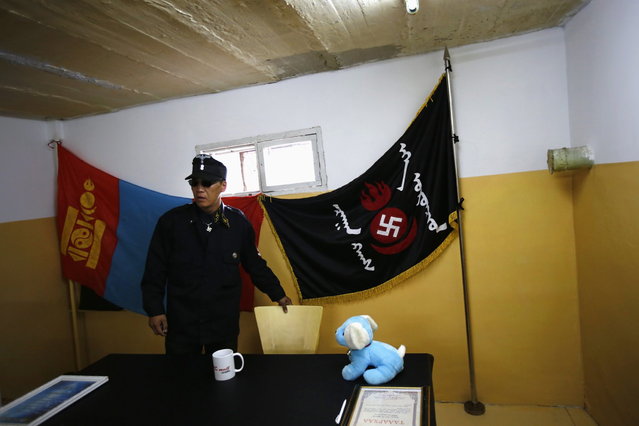
Ariunbold, a leader of the Mongolian neo-Nazi group Tsagaan Khass, arrives at the group's headquarters in Ulan Bator June 24, 2013. (Photo by Carlos Barria/Reuters)

Uranjargal, a leader of Tsagaan Khass, poses for a portrait at the group's headquarters, on June 23, 2013. (Photo by Carlos Barria/Reuters)
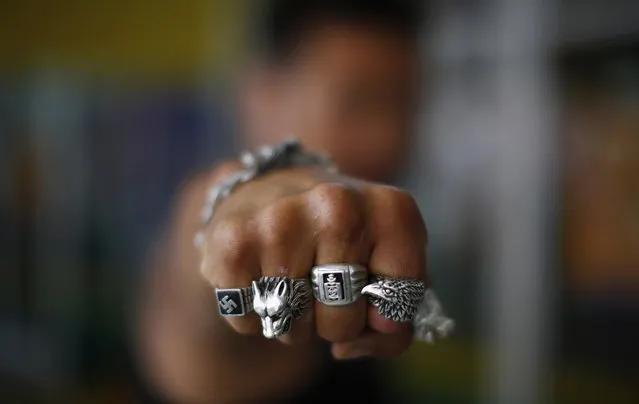
A member of a self-described skinhead group clenches his fist as he trains at a gym in Ulan Bator, on June 22, 2013. (Photo by Carlos Barria/Reuters)
09 Jul 2013 07:23:00,
post received
0 comments
